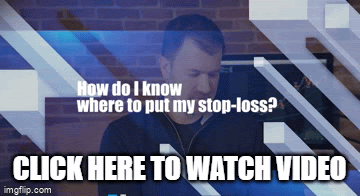You better have two exit strategies before you place a trade.
A profit target…And a stop-loss.
It’s a trader’s way of looking themself in the eyes and saying, “You’re done here kiddo. Why don’t you sit this next play out?”
I can’t think of any element more crucial to successful trading than a stop-loss. In fact, if you don’t fully understand the concept, pause what you’re doing and watch the video below.
I created a quick training video from the ‘Ask Jeff’ series.
This free video will delve into why stop losses work differently than profit targets.
You’ll also learn some rules I’ve developed that have helped me “become a better loser”
Click here to watch “How do I know where to put my stop-loss?”
But after you watch the video, I want you to come back.
Because I want to dive in deeper on some more essential concepts pertaining to stop-losses, and my best practices for managing a trade effectively.
Many targets but one stop-loss
In the video, one of the first concepts I discuss is multiple targets for profit, but one stop.
I know at first this seems counterintuitive, but let me explain.
Chart patterns, and really all technical analysis, boils down to a setup that works a certain percentage of the time. Among the times that it works out, a position can run further than you might realize. The same thing can happen when a trade moves against you.
When a trade hits a stop loss, that could be it, or it could run further. However, at that point, the probabilities tell me that the trade won’t get to my target. That’s why I only use one stop.
If a stock hits my first profit target, I have no idea whether it will turn back around or continue higher. What I do know is that the meat of the trade is done. That’s why I’ll exit a portion of the profit and set my stop at breakeven on the rest.
That’s how I lock in profit, while adding flexibility to my trades.
Scaling trades
Successful trading relies on capital preservation. I want to minimize my losses and maximize my gains. One of the most common ways I do this is with scaling.
Scaling in and out of trades means entering a trade at multiple points between the initial entry and the stop. However, I never move my stop.
When I scale into a trade, I always make sure I know how much I stand to lose. So, I need to preplan my scaling before I start.
For example – say I want to enter Apple at $275. My stop loss would be $270. The most I want to lose on this trade is $500.
If I only entered the trade once, I could buy up to 100 shares ($500 / $5). My average entry price would be $275. If I set my target at $280, I’d make $500.
Now, say I entered the trade at two points: $275 and $272.50. I want to risk $500 total. That means I would be able to buy 50 shares at $275 and 100 shares at $272.50.
Quick math: 50 x $5 + 100 x $2.50 = $250 + $250 = $500.
Let’s say Apple only gives me the first entry. Well, then I can only make $250. However, if I get both entries, then my total profit potential jumps to $1,000.
Quick math: 50 x $5 + 100 x $7.50 = $250 + $750 = $1,000.
Now you see the power of scaling. However, I never move my stop. If the trade flakes, then so be it.
Risk/Reward ratio
Capital preservation relies on creating a favorable risk/reward ratio. In the video, I noted that I like to create a 2 x 1 ratio of reward to my risk for option trades.
That means if I expect to make $100, I want to risk $50.
I know that sounds like the Holy Grail, but hear me out.
In option trading, you have a maximum loss possible – the amount you put in. That’s why most option traders keep their bets small. However, when you go long options, your reward can be significantly higher.
When I pick the right option contract, the chances that I lose more than 50% on any given option trade becomes small (not impossible, but small). When I use scaling, that makes the chances of a huge loss even lower.
However, even if I only get one entry, the potential win for a runner can be multiples of the risk. That’s a large reason why I use options for my trading.
Slippage
One final concept I want to discuss is slippage. I may choose a specific price and exit. But the market won’t always work with me. Sometimes, a stock moves faster, or the bid/ask spread is wider than I expected.
The extra cost I incur is known as slippage. If you’ve ever put a stop loss order in on a stock at $100 and got filled at $99.90, that’s slippage.
Keep this in mind when you strategize your trades. You don’t want to be caught off guard by the extra costs.
Learn about options in a new light
As I mentioned earlier, options offer me flexibility for my trades that I can’t get with stocks. They’re my favorite way to trade the market day in and day out.
That’s why I created my Options Masterclass that you can experience for Free. You’ll learn everything from option basics to stock life cycles. It’s chock-full of goodies to help you advance your trading career.
Click here to register for my free Options Masterclass.

